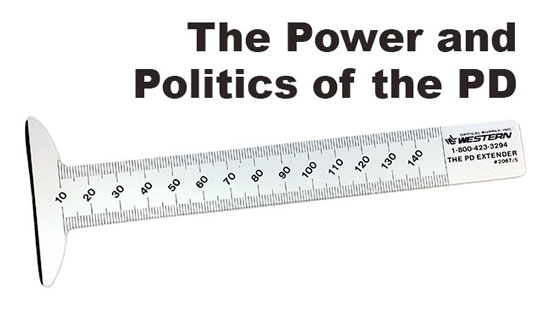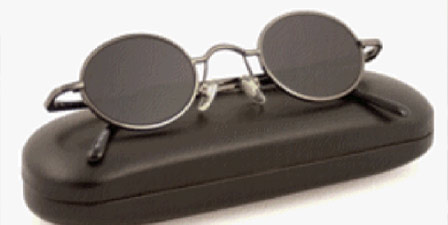
This is a reprint of a 2020 Continuing education divided into four parts.
The Business of PD
The sale of eyeglasses has been the single greatest revenue generator for optical stores. But you can't begin the sale of glasses without first having an Rx, and eye exams are financed in large part through participation in vision care plans (VCPs). For most consumers, the scheduling of exams and availability of eyewear allowances is set through the VCP’s logistics. With plan benefits usually timed to one or two year intervals, it’s easy to see why leveraging the exam visit into a pair of revenue-generating eyewear is very important. So when someone’s Rx appears to be walking out the door, business owners also see the single most important contributor to their bottom line walking out with it.
With the plethora of lower eyewear prices available online, even longtime clients are beginning to question why their “trusted” eye care professional charges more for what appears to be the same product. And contained within that one word — product— is the biggest mistake the optical industry has ever made. By bundling all the consultative, fitting, adjustment, warrantee and other services into a one-price, product-centered transaction, ECPs did themselves a great disservice. Without a separate pricing schedule for services that covered adjustments, repairs, replacement parts, warrantee coverage, consultative time, etc., included in the asking price of eyeglasses, consumers were left with only one thing with which to compare prices and gauge value: the eyewear product alone.
Smell the Coffee
Insulated for years from the competitive realities of the free market, and in part protected by regulations and licensure, ECP’s had little motivation to change the status quo. But although the arrival of big box chains in the 1980s brought independents their first real taste of competition, ECPs were still slow to begin adapting to a new disrupter in their midst. Today, with a variety of alternate channels of distribution for Rx eyeglasses beginning to spring up, eye care professionals are still slow to realize that these new competitors are essentially capitalizing on one thing: The ECP’s mistaken assumption that its customer base had always appreciated all their services were included in the cost of their glasses.
Politics and the PD
The dispensing of prescription eyeglasses, a Class 1 medical device, has been regulated in part by some state requirements that a licensed optometrist or optician to oversee the process of dispensing. As a medical device, any records kept by ECPs are considered medical records, and as such, must be made available to the patient on demand. This would also include the patient's PD. Even in view of this, consumers continue to encounter difficulties obtaining their PD when requested. Therefore the question of what consumers are rightfully entitled to in their eyeglass record is far from being clearly answered. But with consumers becoming comfortable with buying other types of medical products online, they're beginning to ask their government representatives the toughest question: Do prescription eyeglasses really require regulatory oversight?
Product Safety and Regulation
Product safety and efficacy are important concerns for both consumers and eye care professionals. But while the dispensing of eyeglasses by opticians is only licensed in approximately half of all states, there is yet new pressure to remove regulation altogether. While the FDA ensures that consumers face reduced risk from the consequences of compounded injury through their impact resistance requirement, they have not begun to question whether eyewear that lacks compliance with ANSI standards for power or PD will pose a threat of harm.
Evidence-Based Risk Assessment
In our current regulatory environment, efforts to control costs and limit government involvement are constantly under scrutiny and review. Today, regulations are increasingly vetted toward optimal balancing of cost-versus-risk-of-harm. This is the main metric for determining the degree of oversight, regulation and recommendation for medical drugs, tests, procedures and devices. Notwithstanding anecdotes that ECPs recite about patients who needlessly suffered from poorly fitted or miss-fabricated eyewear, there remains a distinct lack of consensus or hard evidence of the risk of long term harm accompanying poorly made eyewear. And hard evidence is what regulators need to substantiate hard regulation.
In 2005, the Canadian Ophthalmological Society issued guidelines for the frequency of oculovisual examinations, including those exams intended to screen individuals for eye disease, provide secondary control of existing disease or tertiary prevention in reducing the consequential harm of chronic disease. In developing their guidelines, the COS employed real-world, evidence-based risk assessment studies. Here is a short excerpt of their surprising conclusions:
Healthy adults, who do not notice anything wrong with their eyes, should see an eye doctor according to the following schedule:
- Age 19 to 40 - at least every 10 years
- Age 41 to 55 - at least every 5 years
- Age 56 to 65 - at least every 3 years
- Over Age 65 - at least every 2 years
NB: Within these same recommendations, the COS cited sufficient evidence-based data to recommend at least one complete eye exam for children before age 5. Meanwhile in the US, only 3 states —Kentucky, Illinois and Missouri — have seen fit to mandate a complete eye exam before a child enters kindergarten.
Please look for part three of this four part series in the Opticians Handbook next week.
 Barry Santini, ABOM, graduated from New York Technical College in 1975 with an AAS in Ophthalmic Dispensing. He is a New York State licensed optician with contact lens certification, is ABO certified and was awarded an ABO Master in 1994. As sales manager for Tele Vue Optics from 1987 to 2003, Santini developed his knowledge of precision optics and has been an owner of Long Island Opticians in Seaford NY, from 1996 to present. Recently The Society to Advance Opticianry named Barry Santini, OO, as the 2016 Ophthalmic Optician of the Year. In addition, Santini is an amatuer astronomer and lecturer and plays bass trombone in the Brooklyn Symphony.
Barry Santini, ABOM, graduated from New York Technical College in 1975 with an AAS in Ophthalmic Dispensing. He is a New York State licensed optician with contact lens certification, is ABO certified and was awarded an ABO Master in 1994. As sales manager for Tele Vue Optics from 1987 to 2003, Santini developed his knowledge of precision optics and has been an owner of Long Island Opticians in Seaford NY, from 1996 to present. Recently The Society to Advance Opticianry named Barry Santini, OO, as the 2016 Ophthalmic Optician of the Year. In addition, Santini is an amatuer astronomer and lecturer and plays bass trombone in the Brooklyn Symphony.













